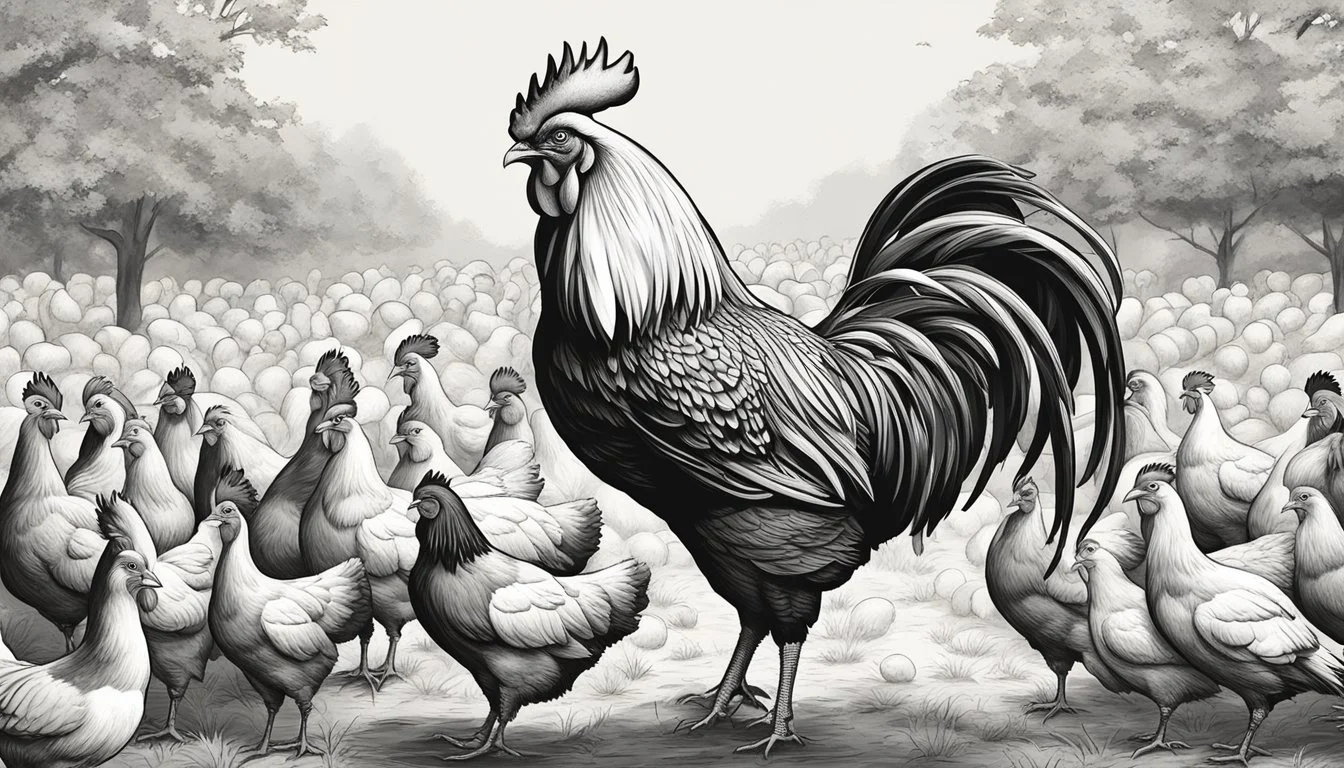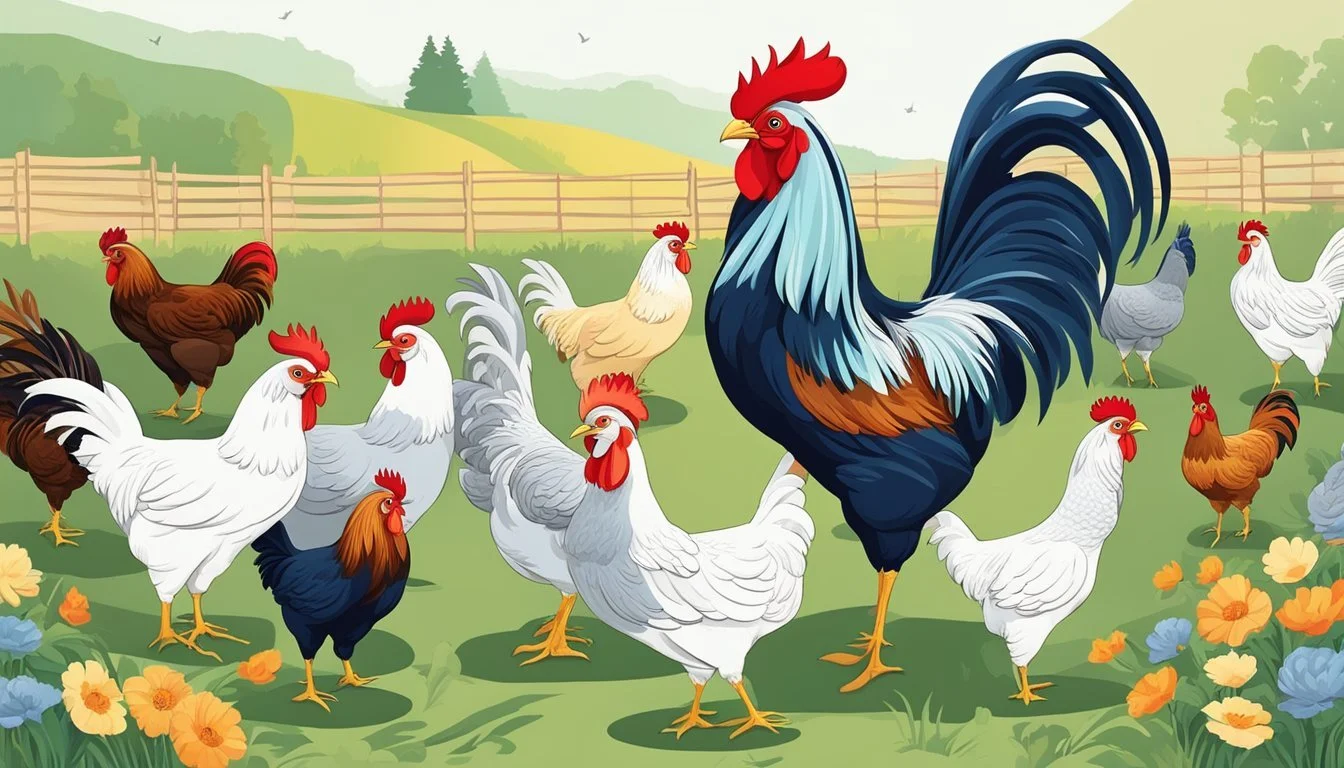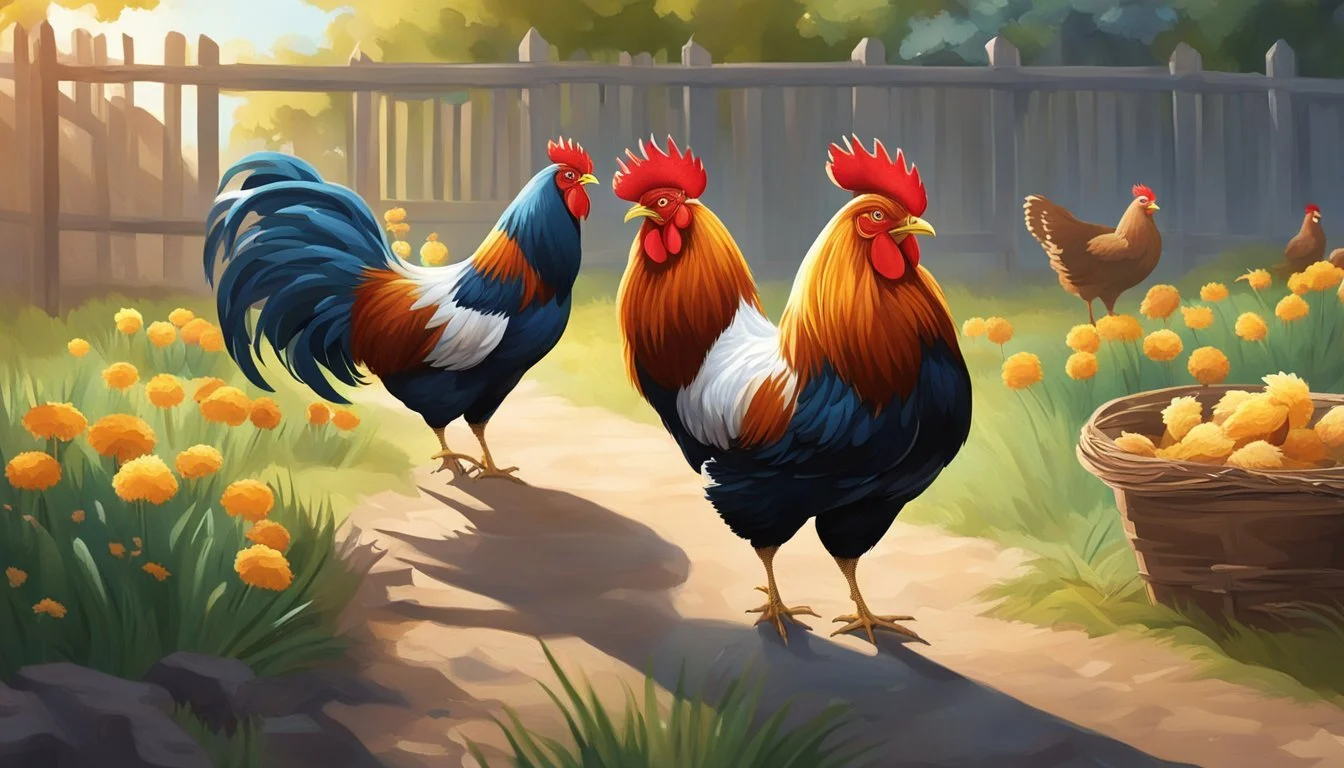How do I manage a rooster in my flock
Essential Tips for Harmony and Productivity
Managing a rooster within a flock requires an understanding of poultry behavior and practical strategies to ensure harmony and productivity among the birds. A rooster can offer significant benefits to a flock, such as protection from predators and natural flock structure. These vigilant birds often occupy the top of the pecking order, keeping hens in line and sometimes preventing bullying among the hens themselves. Their presence can be a majestic addition to the backyard setting or farm, with the added advantage of fertilization leading to chick production if one chooses to breed chickens.
Introducing a rooster to an existing flock of hens demands patience and a methodical approach to minimize stress and conflict. It's crucial to observe the birds closely during this period to ensure that the integration is going smoothly and that neither the rooster nor the hens are harmed in the process. One must remember that a pecking order will be established, and minor altercations may be typical as they sort out their social hierarchy.
Proper care for the rooster is just as important as managing the flock dynamics. This includes providing a balanced diet, clean and spacious living conditions, and regular health checks. It's crucial that the rooster not only fits in with the flock but also is healthy and content to perform its role effectively. Addressing aggressive behavior promptly and ensuring that the rooster is not causing undue stress to the hens is an ongoing aspect of flock management, which can lead to a peaceful and functional poultry environment.
Understanding Roosters
When integrating a rooster into a flock, it is essential for poultry keepers to grasp the unique behaviors and physical attributes that typify these birds. Recognizing signs of aggression and understanding the dynamics of the pecking order can help manage conflicts and promote harmony within the flock.
Behavior and Pecking Order
In a chicken flock, roosters establish a hierarchical structure commonly referred to as the pecking order. This social ladder determines access to resources like food and nesting areas. Roosters display dominance to maintain their position in the hierarchy and to protect hens. Some breeds exhibit higher levels of aggression, but even less aggressive breeds will enforce pecking order. To manage a dominant rooster, poultry owners need to monitor interactions closely, ensuring that submissive creatures, such as hens or younger roosters, are not harmed or overly stressed.
Learning to recognize signs of dominance, such as forceful pecking or posturing, is crucial for intervening when necessary and preventing undue meanness within the flock.
Physical and Vocal Characteristics
Roosters are distinct from hens in both appearance and sound. They are often more colorful and possess larger combs and wattles. In terms of vocal characteristics, the crowing of a rooster is loud and can serve various functions—it is a means to express territory, attract hens, or signal a disturbance. The crow typically becomes consistent as the rooster reaches maturity around 10-20 weeks of age. Residents with nearby neighbors should be mindful of the loud morning calls, which can sometimes be managed by adjusting the roosters' sleeping area to muffle the sound.
Understanding a rooster's physical and vocal characteristics allows one to appreciate their role and manage them effectively. It is the vibrant appearance of a rooster that often elevates the aesthetics of the flock, while their crowing represents communication within their environment.
Housing and Space Requirements
Proper housing and adequate space are critical factors in managing a rooster within a flock. These elements ensure the wellbeing of the rooster and the hens, facilitating a stable and secure environment.
Coop Design and Size
Coop design should cater specifically to the needs of a rooster and his flock. It must be spacious enough to prevent overcrowding, allowing a minimum of 4 square feet of space per chicken inside the coop. For a rooster, additional space may be necessary to accommodate his larger size and more active behavior. Roosting areas should be sturdy and well-spaced to prevent conflicts, particularly with an alpha rooster present, since they tend to claim higher perches.
Creating a Rooster-Friendly Environment
A rooster-friendly environment supports both safety and the natural behaviors of these birds. Protection from predators and extreme weather is a basic requirement, alongside the inclusion of elements like dust baths and perching spaces. If the flock includes a rooster, one must consider establishing a bachelor pad or separate bachelor pen, providing a secure area for male birds to retreat to, reducing aggression and over-mating.
Additionally, free-ranging space is beneficial for roosters and hens alike, as it encourages natural foraging behavior and exercise. However, there must be measures in place to ensure protection during free-range time, such as secure fencing to ward off predators. A well-managed pen or designated free-range area within sight can offer both the freedom they enjoy and the safety they require.
Feeding and Nutrition
Managing the feeding and nutrition of roosters is distinct from that of laying hens, mainly because roosters require different nutrient levels for optimal health.
Understanding Nutritional Needs
Roosters have specific nutritional requirements that differ from hens. Unlike hens, they do not need the extra calcium found in layer feed, which supports eggshell production. Instead, their diet should focus on maintaining muscle mass and overall health. A balance of proteins, vitamins, and minerals is essential, with a particular emphasis on adequate protein intake necessary for muscle development. Options like Purina® Flock Raiser® feed are often recommended for its tailored nutrition suited for non-laying birds like roosters.
Feeding Systems and Schedules
Feeding systems should allow roosters to access food without competition to prevent aggression. Multiple feeders and waterers are advised to ensure every bird gets enough food and water — for a group with more than two roosters, having two or three feeders along with a couple of waterers can help sustain peace and reduce crowding. For feeding schedules, it’s common to feed adult roosters twice a day with measured amounts of grower feed to maintain their condition and prevent obesity, a risk when birds are overfed. Seasonal adjustments to feeding may also be necessary to respond to changes in their activity levels.
Flock Management Practices
Effective flock management is essential when incorporating a rooster. Responsible for mating and often seen as the protector of the hens, understanding a rooster's behavior, maintaining flock balance, and managing breeding and fertilization are critical for harmony and productivity within the flock.
Maintaining a Balanced Flock
When integrating a rooster into a flock, monitoring the ratio of hens to roosters is crucial; it is generally recommended to have about one rooster for every ten hens to prevent overbreeding and stress on the hens. Observing the flock's behavior is key to maintaining balance. Signs of aggression or fights can indicate issues with dominance or an imbalanced ratio. In situations with multiple roosters, careful management is necessary to ensure that these natural leaders can coexist without heightening aggression levels or causing harm.
Managing Breeding and Fertilization
Breeding and fertilization are central to managing a rooster in a hen flock. A rooster will naturally seek to mate with several hens to fertilize eggs and propagate the flock. To manage mating and ensure egg fertilization, a rooster should display healthy and controlled dominance behavior, which can be observed by his interaction with the hens. If a rooster is overly aggressive, it might be necessary to remove him temporarily or consider rehoming to prevent negative impacts on the hen's welfare and egg production. Furthermore, selecting a rooster that is compatible with the flock in terms of size and breed can foster more harmonious breeding behavior.
Dealing with Aggressive Behavior
When managing a flock that includes roosters, a key concern is often how to handle those that exhibit aggressive tendencies. Addressing this challenge requires a balanced approach, focusing on prevention and the consideration of more definitive actions like rehoming or culling.
Prevention and Remediation Strategies
To mitigate aggressive behavior in roosters, owners should implement preventative measures and remediation strategies. Understanding and interpreting rooster body language can prevent escalations; usually, a rooster exhibits signs like flaring of feathers or following before an attack. One can introduce a water spray technique as a deterrent to aggressive roosters, discouraging unwanted behavior without causing harm. However, it's important to maintain a level of protection for oneself and others around the flock, using protective gear if necessary.
For remediation, consistent interaction with the flock helps establish a presence that is seen as a leader rather than a threat. There are non-violent methods recommended to deal with an aggressive rooster, such as isolating them briefly when they act out, which can sometimes help in correcting behavior.
Rehoming vs. Culling as Solutions
In situations where a rooster's aggression cannot be managed through preventative or remedial actions, owners might consider rehoming or culling. The decision to rehome should be taken with an understanding of the commitment to animal welfare, ensuring that the new environment will be suitable and safe for both the rooster and its new flock.
Culling, on the other hand, is a sensitive matter and may be considered as a last resort. It is imperative to abide by ethical practices and local regulations. For those who raise chickens for meat, culling might be more integrated into the flock management practices. However, it is only recommended to cull as a solution to aggression when it poses a substantial risk to the safety of the flock or the handlers and all other measures have been exhausted.
Integrating Roosters into the Flock
Integrating new roosters into a flock requires a careful approach to minimize aggression and stress among birds. Below, two key strategies are outlined: a structured introduction process and tactics for managing and preventing fights within the flock.
Introduction Process for New Roosters
When introducing new roosters, it's critical to start with a quarantine period to ensure they are healthy and to prevent the spread of any diseases. After a successful quarantine, the next step involves placing the rooster within visible but isolated proximity to allow the flock to acclimatize to its presence without direct contact. This can be achieved with a separate cage or enclosure within the run. It is equally important to provide plenty of space to mitigate potential territorial disputes when it's time for the new rooster to roam freely with the flock.
Preventing and Managing Fights
As the rooster integrates, observing the flock's interaction is crucial to prevent injuries from fights due to natural issues of dominance. Reducing competition for resources by ensuring multiple feeding and watering stations can prevent some aggression. Intervening in fights should be done with care to avoid personal injury or exacerbating the conflict. It may be necessary to rehome a rooster if the aggression is unmanageable or poses a risk to the wellbeing of the flock.
Protecting Your Flock from Predators
Ensuring the safety of a flock often involves both biological and structural strategies. A vigilant rooster and fortified coop and pen are fundamental to protecting chickens from predators.
The Role of a Rooster in Guarding
Although not a foolproof deterrent, a rooster serves as a natural guardian for a flock. They are often alert to threats and will sound an alarm, signaling hens to seek shelter. The presence of a rooster can also deter certain predators, due to their aggressive behavior in defense of their flock. However, having a rooster is just one aspect of a predator management plan.
Enhancing Coop and Pen Security
To effectively protect your flock, enhancing the security of the coop and pen is essential. Here are specific measures to consider:
Cover the Pen: Utilize materials like hardware cloth to cover the run, preventing entry from flying and climbing predators. Simple netting may deter hawks but won't stop climbing creatures.
Fortify the Coop:
Use solid locks: Trash can latches often fail to secure against raccoons and other intelligent predators.
Dig a trench: Bury hardware cloth or a wire mesh along the perimeter to prevent digging.
Regular inspections: Check for vulnerabilities and signs of attempted entry frequently.
By implementing both biological alert systems like a rooster and physical barriers, you create a multi-layered defense against predation. These measures, when regularly inspected and maintained, contribute significantly to the well-being and longevity of your chickens.
Breeds of Roosters and Their Traits
The breed of a rooster plays a significant role in its behavior and suitability for your homestead. Some breeds are known for their docility, while others may display more aggressive tendencies.
Choosing the Right Rooster Breed for Your Homestead
When selecting a rooster, it's crucial to consider the specific needs of your homestead and flock. Breeds such as Australorps and Orpingtons are typically calm and can blend well in a mixed flock, often proving to be less aggressive than other breeds. Brahmas are another option that is not only gentle but also tolerates confinement well, which might be important if space is limited. For those with space constraints, Bantams are small and consume less food, but they are not the best for protecting the flock against predators.
Understanding the typical mating behavior of your chosen breed is also essential. Roosters like the Australorp and Orpington can mate without causing harm to the hens, whereas some breeds may require monitoring to prevent overbreeding.
Understanding Breed-Specific Behaviors
Rooster behaviors can vary significantly from breed to breed. Knowing these can help you manage your flock more effectively. An Australorp rooster, for instance, often exhibits a protective nature without being overly aggressive towards humans, making them an excellent choice for first-time chicken owners. On the other hand, certain lines of Brahmas are notable for their calm demeanor, yet they are also capable of standing their ground against intruders.
Bantams, due to their size, may not offer much in terms of protection but can be incredibly social and interactive, which might be appealing for pet owners. However, there's a possibility of running into aggressive roosters within any breed, though this is generally the exception rather than the rule. Selective breeding and proper upbringing can mitigate this trait to an extent.
Legal and Cultural Considerations
Before introducing a rooster to a flock, one must be aware of local laws, as well as the cultural dynamics within their community. It's crucial to comply with regulations to avoid legal consequences and to maintain good relations with neighbors.
Local Regulations on Keeping Roosters
Laws Vary by Location: Local ordinances dictate whether it's permissible to keep roosters. In some areas, they are banned outright. For example, urban settings often restrict keeping roosters due to noise concerns. One must check with city or county government bodies to understand these regulations.
Legal Requirements: If roosters are allowed, there may be specific requirements regarding their care. This can range from the number allowed on a property to enclosures standards that mitigate noise. Noncompliance with these stipulations can result in fines or the removal of the birds.
Cultural Attitudes and Neighborhood Relations
Cultural Sensitivity: The cultural acceptance of keeping roosters can vary significantly. In rural areas where farming is prevalent, roosters are commonly accepted as part of the community. However, in suburban or urban environments, neighbors might view them as a nuisance due to their crowing.
Building Goodwill: Maintaining open communication with neighbors is essential to avoid disputes. This includes informing them about one's intent to keep a rooster and taking steps to minimize disturbances. Providing neighbors with fresh eggs can sometimes help in fostering positive relations.






